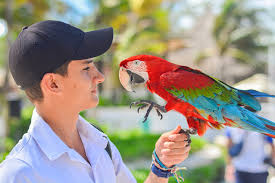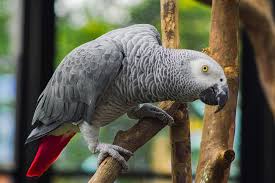Observing birds in the wild provides a window into their world of communication. Each tweet, chirp, and song isn’t just random noise; it’s a sophisticated system for bonding with their flock, navigating the perils of migration, and warning of predators. When a bird becomes part of your family, they don’t leave these instincts behind; they adapt them to their new ‘flock’ – you and your household.
Much like humans, birds come hard-wired to communicate. Research suggests that the brain processes involved in their vocalizations share striking resemblances with how children learn language. It makes sense, then, that birds bond and connect with us through mimicry. By reproducing the sounds they frequently hear, they’re not just showing off their vocal prowess; they’re trying to fit in.
African Grey , Amazon Parrots and Parakeets, top the list of birds that can talk . These species seem to possess an innate knack for human speech, commanding large vocabularies that sometimes even include multiple languages. If you’re dreaming of daily banter with a feathered friend, these are the go-to companions.
. These species seem to possess an innate knack for human speech, commanding large vocabularies that sometimes even include multiple languages. If you’re dreaming of daily banter with a feathered friend, these are the go-to companions.
Now, keep in mind that birds don’t start chattering right out of the egg. Most begin to vocalize rhythmic sounds resembling speech around the one-year mark. Learning to talk is, for them, a gradual and natural process. Embedding this understanding into our approach is the first step towards transforming squawks and tweets into ‘hello’ and ‘I love you’.
Moving into the next phase of training, building a relationship on a foundation of trust becomes paramount. Birds are intelligent and sensitive; they’ll pick up on your cues and react accordingly. They thrive on positive reinforcement, much like we do. The effort you invest here lays the groundwork for all the learning that’s to come.
Creating a Foundation of Trust with Your Bird
When training a pet bird to talk, the groundwork of the entire process is trust. Just as humans are more receptive to learning from those they trust, birds are similarly disposed. To start, you’ll want to ensure your feathered friend feels safe and cared for in your presence. This includes providing a comfortable habitat, consistent interaction, and gentle handling.
I’ve found that nothing builds a bond quite like the right incentives. Treats work wonders for creating positive associations. A sliver of apple or a sunflower seed given as a reward can quickly become a highlight for your bird. Affectionate gestures like head scratches or softly spoken words also play a significant role in strengthening your bond.
Another crucial element is shared enjoyment. Discover what activities your bird enjoys. It may be a game of ‘fetch’ with a small ball, some light dancing to music, or simply the time spent perched on your arm. Engaging in these activities together reinforces trust and companionship.
KEEP IN MIND, consistency is your ally. Each interaction is an opportunity to build trust. Regular, positive experiences reinforce your bird’s confidence in you, paving the way for effective communication training. As your bond deepens, you’ll notice a strong foundation forming—an essential base on which the rest of your training will build.
Effective Training Techniques for Teaching Your Bird to Talk
Embarking on the journey of training your bird to talk is an exercise in patience and attentiveness. The process is straightforward, but it demands dedication. Your bird’s ability to speak begins with the right incentives. Most birds are keen on snacks like peanuts, sunflower seeds, or small pieces of cracker. These treats not only motivate your feathered friend but also create a strong association between speaking and good experiences.
Begin with simplicity. Choose words or phrases that you can repeat easily and that your bird will hear often. ‘Hello’, ‘Good bird’, or your bird’s name are excellent starting points. Consistent repetition is vital. Birds learn through imitation, so the more they hear the word, the likelier they are to attempt it. Speak clearly and maintain eye contact to reinforce the personal connection.
Progress should be introduced gradually, emphasizing patience. Once the bird has mastered a word or phrase, you can slowly introduce new ones. This mimicking process is similar to how young children learn to speak. Remember, every bird is unique, and some may advance faster than others. Celebrate each milestone to encourage further learning.
An essential aspect of training is knowing what NOT to feed your bird. Avoid avocados, chocolate, salty foods, and caffeine, as these can be harmful. Always consult a vet for advice on a proper diet. That way, you’re ensuring their health and keeping them primed for learning.
Managing and Encouraging Desired Behaviors in Your Talking Bird
Any seasoned bird trainer will tell you that not every chirp or phrase from your feathered friend will be music to your ears. Sometimes, they pick up sounds or words that you’d rather they didn’t repeat. How you respond to these undesired behaviors is crucial; the key is to remain calm and patient. If your bird makes an unwanted noise, simply ignore it. This lack of response will convey that those sounds aren’t the way to earn your attention or treats.
Instead, make a point of lavishly rewarding the sounds you do want to encourage. When your bird gets it right, offer immediate praise or a nibble of their favorite snack. This positive reinforcement makes it more likely they’ll repeat those desirable words or tunes.
The process of training your bird requires, above all, consistency. You won’t see results overnight, but with regular practice and a wealth of patience, your bird will slowly but surely expand their vocabulary. Be gentle, be consistent, and give your bird the time they need to learn at their own pace.
As you embark on this journey together, remember that training your pet bird to talk is more than just about teaching them to mimic sounds. It’s about forging an extraordinary bond and enjoying the unique companionship that a talking bird can offer. The experience is indeed enriching for both you and your pet, as it goes far beyond simple communication. Cherish the moments of breakthrough, and find joy in the process.

